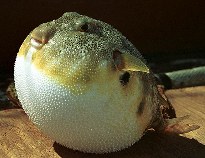Sphoeroides maculatus (Bloch & Schneider, 1801)
Northern puffer
إضافة ملاحظاتك Fish Watcher
| Native range | All suitable habitat | Point map | Year 2050 |

|
| This map was computer-generated and has not yet been reviewed. |
| Sphoeroides maculatus AquaMaps Data sources: GBIF OBIS |
ارفع صور و مقاطع فيديو
Pictures | صور قوقلSphoeroides maculatus
Picture by JJPhoto
Pictures | صور قوقلSphoeroides maculatus
Picture by JJPhoto
United States (contiguous states) country information
Common names:
Chicken-of-the-sea, Green eye, Northern puffer
Occurrence: native
Salinity: brackish
Abundance: | Ref:
Importance: | Ref:
Aquaculture: | Ref:
Regulations: | Ref:
Uses: no uses
Comments:
National Checklist:
Country Information: https://www.cia.gov/library/publications/resources/the-world-factbook/geos/us.html
National Fisheries Authority: http://www.nmfs.gov
Occurrences: Occurrences Point map
Main Ref: Robins, C.R. and G.C. Ray, 1986
National Database:
Occurrence: native
Salinity: brackish
Abundance: | Ref:
Importance: | Ref:
Aquaculture: | Ref:
Regulations: | Ref:
Uses: no uses
Comments:
National Checklist:
Country Information: https://www.cia.gov/library/publications/resources/the-world-factbook/geos/us.html
National Fisheries Authority: http://www.nmfs.gov
Occurrences: Occurrences Point map
Main Ref: Robins, C.R. and G.C. Ray, 1986
National Database:
Common names from other countries
التصنيف / Names الأسماء الشائعة | مرادفات | Catalog of Fishes(جنس, الانواع) | ITIS | CoL | WoRMS | Cloffa
> Tetraodontiformes (Puffers and filefishes) > Tetraodontidae (Puffers) > Tetraodontinae
Etymology: Sphoeroides: Greek, sphaira = ball + Greek, suffix, oides = similar to (Ref. 45335).
More on authors: Bloch & Schneider.
Etymology: Sphoeroides: Greek, sphaira = ball + Greek, suffix, oides = similar to (Ref. 45335).
More on authors: Bloch & Schneider.
Environment: milieu / climate zone / depth range / distribution range البيئة
بحري; مياه مخلوطة القاع; نطاق العمق 10 - 183 m (Ref. 5951). Temperate; 54°N - 29°N
التوزيع دول | مناطق الفاو | النظام البيئي | الظهور | Point map | مقدمة | Faunafri
Western Atlantic: Newfoundland in Canada to northeastern Florida in USA.
الحجم / وزن / العمر
Maturity: Lm ? range ? - ? cm
Max length : 36.0 cm TL ذكر/ مختلط الجنس; (Ref. 7251); common length : 20.0 cm TL ذكر/ مختلط الجنس; (Ref. 3821)
Max length : 36.0 cm TL ذكر/ مختلط الجنس; (Ref. 7251); common length : 20.0 cm TL ذكر/ مختلط الجنس; (Ref. 3821)
وصف مختصر مفاتيح التعريف | الوصف الخارجي | قياسات المظهر الخارجي
الأشواك الظهرية (المجموع) : 0; الأشعة الظهرية الناعمة (المجموع) : 8; شوكة شرجية: 0; أشعه شرجية لينه: 7. Upper side grey or brown with poorly defined black spots and saddles. Belly yellow to white. Tiny jet-black pepper spots (about 1 mm in diameter) scattered over most of pigmented surface, particularly evident on cheeks. Lower sides with a row of black, elongate, bar-like markings. No lappets on head or body (Ref 53033).
Inhabits bays, estuaries and protected coastal waters. Sold as `sea squab' in northern part of range. Feeds primarily on shellfish, occasionally on finfish. Reportedly non-toxic.
Life cycle and mating behavior النضج | التكاثر | وضع البيض | بيض | الخصوبة | Larvae
المرجع الرئيسي
Upload your references | مراجع | المنظم : Matsuura, Keiichi | المتعاونين
Robins, C.R. and G.C. Ray, 1986. A field guide to Atlantic coast fishes of North America. Houghton Mifflin Company, Boston, U.S.A. 354 p. (Ref. 7251)
خطر للأنسان
Harmless
استخدامات بشرية
مصائد: غير مهمة تجارياً; حوض مائي: تجاري
FAO(مصائد: الأنتاج; publication : search) | FishSource | البحر حولنا
مزيد من المعلومات
Population dynamics
معاملات النمو
Max. ages / sizes
Length-weight rel.
Length-length rel.
الطول- الترددات
Mass conversion
توظيف
الوفرة
معاملات النمو
Max. ages / sizes
Length-weight rel.
Length-length rel.
الطول- الترددات
Mass conversion
توظيف
الوفرة
Physiology
Body composition
Nutrients
استهلاك الأوكسجين
نوع السباحة
سرعة السباحة
Visual pigments
Fish sound
Diseases & Parasites
Toxicity (LC50s)
Body composition
Nutrients
استهلاك الأوكسجين
نوع السباحة
سرعة السباحة
Visual pigments
Fish sound
Diseases & Parasites
Toxicity (LC50s)
Human related
Aquaculture systems
ملامح تربية الأحياء المائية
سلالات
Ciguatera cases
Stamps, coins, misc.
Aquaculture systems
ملامح تربية الأحياء المائية
سلالات
Ciguatera cases
Stamps, coins, misc.
أدوات
E-book | دليل الميدان | مفاتيح التعريف | Length-frequency wizard | أداة تاريخ الحياة | نقطة علي الخريطة | Classification Tree
| Catch-MSY |
تقارير خاصة
البحث عن صيانت الأحواض المائيه | التحقق من وجود صفحات حقائق الأنواع | البحث عنا حقائق حول الأحواض المائيه
Download XML
مصادر علي الأنترنت
Aquatic Commons | BHL | Cloffa | Websites from users | البحث في مراقبي الأسماك | CISTI | Catalog of Fishes(جنس, الانواع) | DiscoverLife | ECOTOX | Faunafri | Fishtrace | GenBank(الوراثة, نيوكلوتيدة) | GloBI | GOBASE | | Google Books | Google Scholar | Google | IGFA World Record | MitoFish | Otolith Atlas of Taiwan Fishes | احواض مائية عامة | PubMed | Reef Life Survey | RFE Identification | Scirus | SeaLifeBase | شجرة الحياة | Wikipedia(ذهب, بحث) | World Records Freshwater Fishing | سجلات علم الحيوانات
Estimates based on models
Preferred temperature (Ref. 115969): 4.9 - 24.4, mean 9.3 (based on 71 cells).
Phylogenetic diversity index (Ref. 82804): PD50 = 0.5000 [Uniqueness, from 0.5 = low to 2.0 = high].
Bayesian length-weight: a=0.02291 (0.01031 - 0.05092), b=2.89 (2.72 - 3.06), in cm Total Length, based on LWR estimates for this Genus-body shape (Ref. 93245).
مستوى غذائي (Ref. 69278): 4.0 ±0.66 se; based on food items.
المرونه (Ref. 120179): عالي, الحد الزمني الأدني لتضاعف عدد أفراد المجتمع أقل من 15 شهر (K=0.6).
Fishing Vulnerability (Ref. 59153): Low vulnerability (24 of 100).
Climate Vulnerability (Ref. 125649): Low vulnerability (22 of 100).




